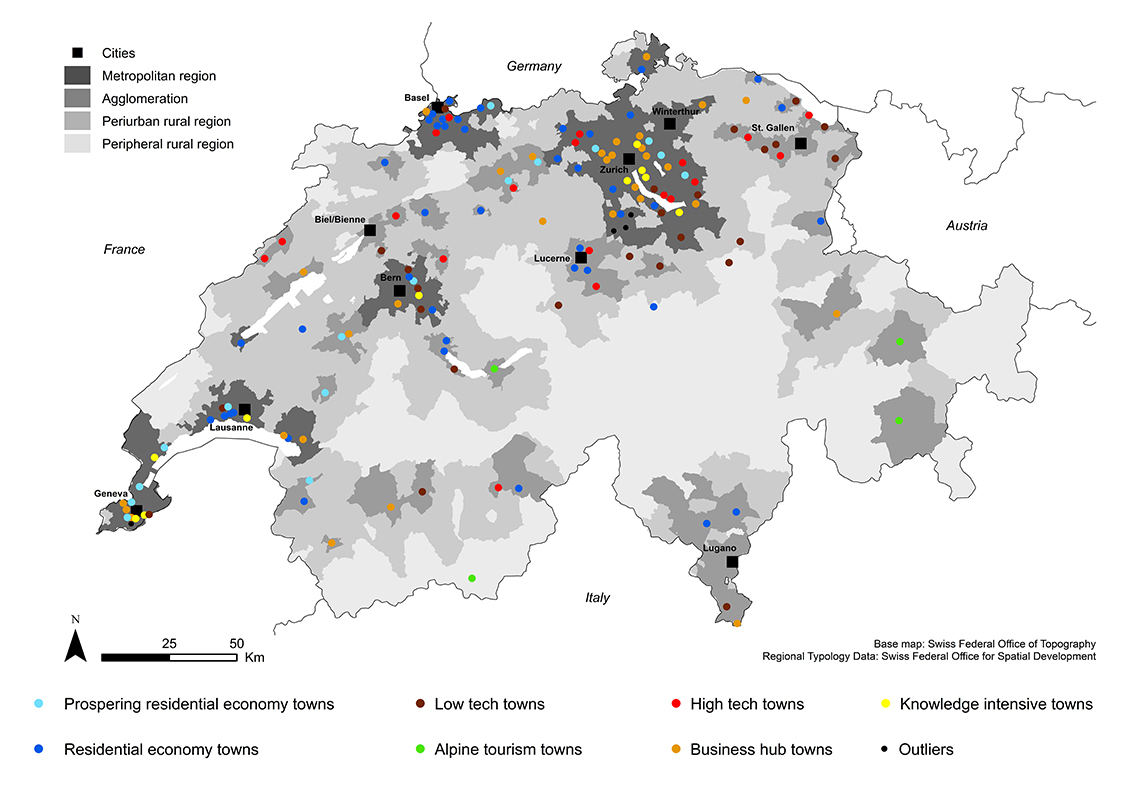Politics and administration
Small and medium-sized towns are more innovative than you might think
For a long time, policy and research have primarily focused on large cities. Now, in an interdisciplinary project funded by the Swiss National Science Foundation, a team of researchers led by Professor of Economic Geography Heike Mayer and Professor of Political Sciences Fritz Sager have analyzed Switzerland's small and medium-sized towns (SMSTs) in three separate studies. In the first step of their investigation, the researchers grouped 152 towns with up to 50,000 residents into seven types. They discovered that SMSTs have very different economic characteristics. Heike Mayer emphasizes: “National policy still hasn’t found a way to address the heterogeneity of SMSTs, so it lumps them all together.”
Division into seven types
To group the small and medium-sized towns into different types, Mayer’s research team worked with data obtained from the Federal Office of Statistics. Ittigen near Bern was grouped with “prospering residential economy towns”, which enjoy high growth rates in terms of population size and the number of full-time jobs. The federal government has outsourced many administrative units to Ittigen, creating new jobs and making it more attractive for commuters. The number of full-time jobs is also rising sharply in so-called “business hub towns”, which feature more top company headquarters than other SMSTs. One good example is the town of Kloten, home to Zurich Airport. “High tech towns” such as Uzwil (Canton of St. Gallen), which are characterized by specialized high tech industries, have below-average population and employment growth rates unless they are located inside large metropolitan regions. Even when SMSTs are clustered in the same region, they may still show very different economic characteristics. The typology is not determined by the region, yet it is influenced by it: The stronger a region’s growth, the more likely individual SMSTs are to grow as well.

Local policy strategies
The economic success of towns also depends on how local planning strategies make use of existing resources. Rahel Meili together with her colleague David Kaufmann, a political scientist, conducted on-site qualitative interviews with officials and policymakers. Using the Zurich metropolitan region as an example, their investigation shows that small towns can influence their economies mainly through spatial planning. Spatial planning, they say, is “the driving factor in population and job market growth”. The research team thus recommends that national spatial planning initiatives such as Raumkonzept Schweiz take SMSTs more into account.
Did you know?
"Wädenswil (Canton of Zurich) has for some years been pursuing a strategy of becoming a center for education and research – it is home to the Zurich University of Applied Sciences Wädenswil (ZHAW) and the Agroscope, the Swiss center of excellence for agricultural research."
Companies as innovation boosters
Heike Mayer was particularly struck by the fact that the companies in SMSTs are more diverse and imaginative than previously assumed. Because these companies need many different kinds of workers, they draw people from other regions and countries. And the companies make the most of their advantages. Mayer emphasizes: “Small and medium-sized towns can be innovative too.” As a result of their visits to companies, the researchers concluded that the social structure of SMSTs and the lively exchange ensure a strong sense of local identity and community.
New perspectives from research
According to Mayer, the results of the field research on SMSTs should be viewed in the light of international developments. Previously, the policy and research view of towns was shaped mainly by the experience of large cities. For economic geography, the idea that SMSTs can strategically plan their own diversity and be economically dynamic and successful is new and exciting. Heike Mayer concludes: “European policy and research have been discovering small towns since about 2015. This is probably due, on the one hand, to life in big cities becoming too expensive and, on the other, to the fact that SMSTs are now easily accessible and attractive.